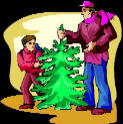
UK Christmas Tree Varieties / Types
Click here for a PDF Print version to take with you to the farm or lot.
(With the PDF, you can print just the table or pages of the trees you like!)
Looking for the right tree, but don't know which variety is right for you? This guide will help you decide which Christmas Tree species or types sold and grown in the UK is worth the price and has the properties you want. Click on the links below for more information about each type. The links for photos and more info open new windows, so just close them to return to this page. In general, the Noble Fir, Nordmann Fir and Lodge Pole Pine are low needle drop trees and the Norway Spruce (the traditional tree) loses needles more quickly than the others in a hot room.
|
Selection Guide to the Most Common Christmas Tree Varieties in the UK All varieties (including those not in the table), are on the page below Ratings: 5= best, 4= very good, 3= average, 2= fair, 1= worst |
||||||||
| Firs | Pine | Spruces | ||||||
|
Needle Holding (without water) |
5 | 5 | 5 | 5 | 5 | 3 | 1 | 4 |
|
Needle Holding (with water) |
5 | 5 | 5 | 5 | 5 | 4 | 2 | 5 |
| Firmness Branches | 2 | 3 | 3 | 5 | 2 | 4 | 3 | 5 |
| Fragrance | 5 | 5 | 4 | 3 | 4 | 1 | 3 | 3 |
| Needle softness | 5 | 5 | 5 | 2 | 5 | 3 | 3 | 3 |
| Cost | 2 | 3 | 3 | 5 | 4 | 3 | 2 | 1 |
|
|
||||||||
Firs
- Pines - Spruce - Cedars
- Cypress -
Potted Christmas Trees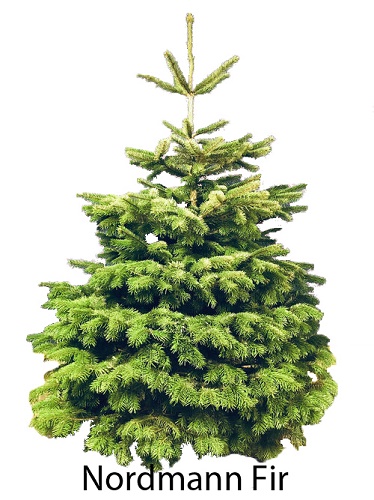
![]()
Firs
Nordmann Fir -
By far, the most popular variety of Christmas tree in the United Kingdom, it is an excellent needle retaining species with soft glossy dark green
needles. Nordmann Firs originate from the Caucasus mountains in Georgia,
southern Russia and have seen a steady rise in popularity over recent years.
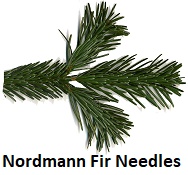
They are a non needle-drop variety with a darker green coloured foliage and slightly more rounded needles.
An excellent needle retaining species with soft glossy dark green needles. Nordmann (sometimes spelt "Nordman") Fir is probably the most popular Christmas tree in this country, one of the reasons being that it has a lovely symmetrical shape with strong branches. The needles are shiny, mid green and soft to touch.
Nordmann Firs are the preferred Christmas tree on the continent, with long, full, lush, dark green foliage, similar to a Fraser fir, but softer to the touch and with excellent needle retention. The Nordmann Fir Christmas Trees can reach 60 feet in height with a spread of 25 to 30 feet.
Their soft and lustrous black-green needles stem from symmetrically arranged branches, producing the ideal pyramidal specimen for a Christmas tree. Nordmann Firs are also popular as ornamental trees in parks and gardens.
See the photo at right.
Balsam Fir -
Balsam Firs are rare in the UK, only sold in a handful of tree farms in Essex and
Leicestershire.
Needles are 3/4" to 1 and 1/2" short, flat, long lasting that
are rounded at the tip. The needles are a nice, dark green colour with silvery cast and
fragrant.
These needles last a
very long time. This is the traditional American Christmas tree.
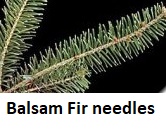
This tree has a dark-green appearance and retains its pleasing fragrance throughout the Christmas season. Named for the balsam or resin found in blisters on bark. Resin is used to make microscope slides and was sold like chewing gum; used to treat wounds in the U.S. Civil War in the 1860's.
.
Canaan Fir -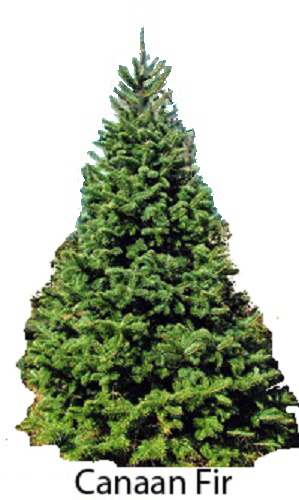
Similar to the other fir trees, Canaan Fir has short, soft needles that are dark green on the upper surface and silvery blue on the underside.
It combines the strong fragrance of the Balsam Fir with the better needle retention of the Fraser Fir.
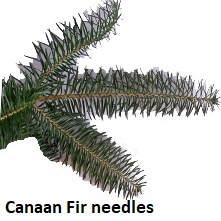
It is native to isolated pockets in the eastern U.S. mountains of West Virginia and Virginia, but is commercially grown in many areas of the U.K..
Douglas Fir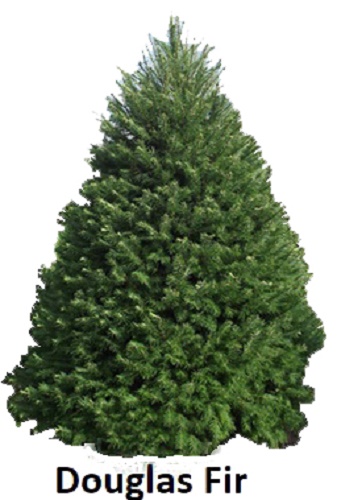 -
-
Douglas Firs have a good fragrance; holds blue to dark green; 1" to 1 and 1/2"
needles. The needles have one of the best aromas among Christmas trees
when crushed. 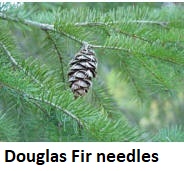
The Douglas fir needles radiate in all directions from the branch. When crushed, these needles have a sweet fragrance.
They are one of the top major Christmas tree species in the U.S. Named after David Douglas who studied the tree in the 1800's. The trees have a naturally good conical shape and can live for a thousand years.
Fraser Fir 
Fraser Firs (sometimes misspelled Frazer Firs) have dark green, flattened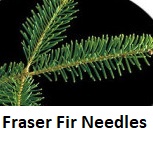 needles; 1/2 to 1 inch long, dark green on the top and silvery underneath;
needles; 1/2 to 1 inch long, dark green on the top and silvery underneath;
The tree has good needle retention; nice scent; pyramid-shaped strong branches which turn upward. The Fraser fir branches turn slightly upward. They have good form and needle-retention.
The dark blue-green needles have a pleasant scent, and excellent shipping characteristics as well.
The tree is named for a botanist, John Fraser, who explored the southern United States Appalachian mountains in the late 1700's.
Grand Fir -
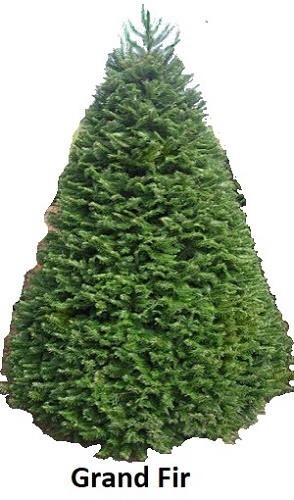 Grand Fir trees are not yet
common in the UK, but can be found in Wales, Scotland and Northern Ireland. have shiny, dark green needles about 1" - 1 and 1/2" long; the blunt
needles when crushed, give off a citrusy smell. They are a yellowish-green on top surface with white bands on underside. The needles alternate in
two lengths (on each tree) alternating longer and shorter which gives the branches a fuller look. Unlike the Douglas fir, Grand Fir needles are
aligned in the same plane coming off the branch. Grand Firs commonly grow only on the U.S. Pacific northwest coast.
Grand Fir trees are not yet
common in the UK, but can be found in Wales, Scotland and Northern Ireland. have shiny, dark green needles about 1" - 1 and 1/2" long; the blunt
needles when crushed, give off a citrusy smell. They are a yellowish-green on top surface with white bands on underside. The needles alternate in
two lengths (on each tree) alternating longer and shorter which gives the branches a fuller look. Unlike the Douglas fir, Grand Fir needles are
aligned in the same plane coming off the branch. Grand Firs commonly grow only on the U.S. Pacific northwest coast.
The Grand Fir is related to the white fir, and is also called the great silver fir, western white fir, Vancouver fir, or
Oregon fir. It mostly grows at altitudes from sea level to 1,800 m.
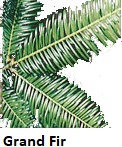
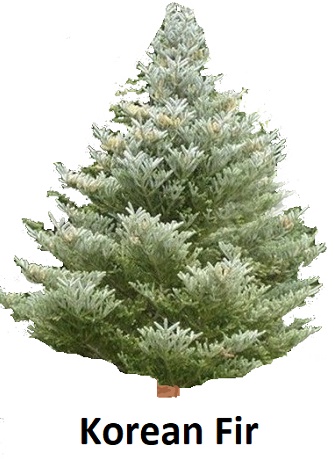
Korean Fir -
This is a new variety to the UK.
It
has silvery underside needles and a fresh pine smell.
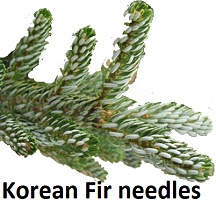 The needles curl in a unique
way, displaying both green and white-silver colours that is quite striking in appearance.
The needles curl in a unique
way, displaying both green and white-silver colours that is quite striking in appearance.
The appearance is similar to the Norway Spruce and the Nordmann, with a distinctive smell.
Korean Spruce are better at keeping their needles than the Norway Spruce (it still needs to be watered every day) with that special fresh pine smell that fills the room.
 Noble Fir -
Noble Fir -
Noble's have one inch long, bluish-green needles with a silvery appearance; has short, stiff branches; great for heavier ornaments; keeps well.
These needles turn upward, exposing th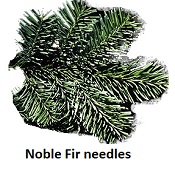 e lower branches.
It's extremely aromatic, and while it is native to the West Coast of
the U.S.,
it is popular throughout the U.K. It's shape is similar
to a Douglas fir but with a deeper, richer green.
e lower branches.
It's extremely aromatic, and while it is native to the West Coast of
the U.S.,
it is popular throughout the U.K. It's shape is similar
to a Douglas fir but with a deeper, richer green.
Known for its beauty, the noble fir has a long keep ability, and its stiff branches make it a good tree for heavy ornaments, as well as providing excellent greenery for wreaths and garland.
White Fir or Concolour Fir -
White Fir trees have blue-green needles are 1/2 to 1/2 inches long; nice shape and good aroma, a citrus scent; good needle retention.
They have good foliage colour, good needle retention, and a pleasing shape and aroma.
In nature, they can live to 350 years.

Spruce
Norway Spruce -
Norway Spruce needles are 1/2" to 1" long and shiny, dark green.
Needle
retention is poor without proper care; strong fragrance; nice conical shape.
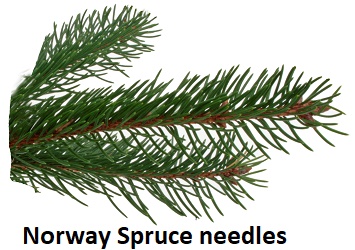
The Norway Spruce is the traditional Christmas tree which can be found in many homes throughout the UK and Europe.
Norway Spruce can be found naturally in Northern and Central Europe.
The tree features pointed mid-green colour needles with long cylindrical brown cones which hang down. Many people enjoy its scent once its indoors during December.
Blue Spruce - 
Picea pungens, the Blue Spruce is a naturally symmetrical tree that has dark green to powdery blue; very stiff needles,
which are 3/4" to 1 and 1/2" long.
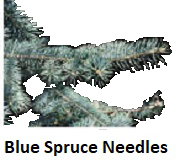
They will drop needles in a warm room; but is still best among spruce varieties for needle retention.
The branches are stiff and will support many heavy decorations.
It can live in nature 600-800 years. The needles really do have a bluish look to them, as shown in the photo at right.
Colorado Blue Spruce -

Oft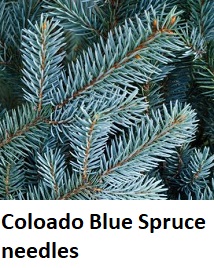 en used for stuffing pine-pillows, these sharp
needles are 1 - 1 and 1/2 in. in length.
en used for stuffing pine-pillows, these sharp
needles are 1 - 1 and 1/2 in. in length.
This species is bluish-gray in colour and has a bad odour when needles are crushed. Colorado Blue Spruces have good symmetrical form and has an attractive blue foliage.
It also has good needle retention.
 Serbian Spruce -
Serbian Spruce -
Serbian spruce is native to a small region of limestone
mountains along the upper Drina river of Bosnia and Serbia, in Southeastern
Euro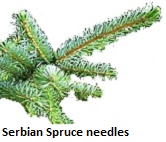 pe.
pe.
The upper surface of the needles is glossy, dark green in contrast to the whitish lower surface.
 White
Spruce -
White
Spruce -
White Spruce needles are 1/2 to 3/4 inch long; green to bluish-green, short,
stiff needles. The crushed needles have an unpleasant odour; good needle
retention. State tree of South Dakota. The White Spruce is excellent for
ornaments; it's short, stiff needles are 1/2 - 3/4 in. long and have a blunt
tip. They are bluish-green - green in colour, but have a bad aroma when
needles are crushed. They have excellent foliage colour and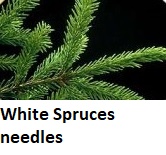 have a good,
natural shape. The needle retention is better in a White Spruce than it is
among other spruces.
have a good,
natural shape. The needle retention is better in a White Spruce than it is
among other spruces.
Pines
Afghan Pine -
Afghan Pines have soft, short needles with sturdy branches; open appearance; mild fragrance.
It keeps well. Many are grown in Texas; but it is native to Afghanistan, Russia and Pakistan.
Also called: Mondell Pine, Lone Star Christmas Tree, Pinus Eldarica.
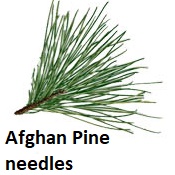
Austrian Pine -
Austrian Pines have dark green needles that are 4 to 6 inches long and it retains needles well. They have a mo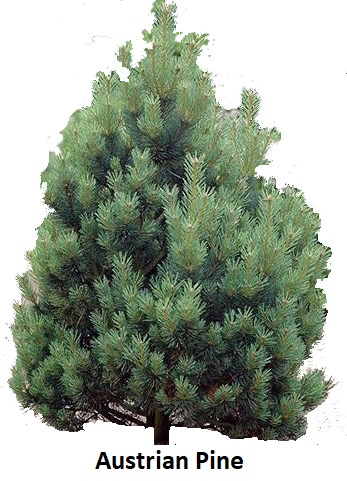 derate
fragrance.
derate
fragrance.
It is native to Austria, northern Italy and southern Mediterranean Europe from Spain to the eastern Mediterranean.
Historians suggest that it may have been one of the original Christmas trees, as it was worshipped by the Romans over 2000 years ago
.
Lodgepole Pine -
The Lodge Pole Pine Christmas tree is a native to the Rocky
Mountains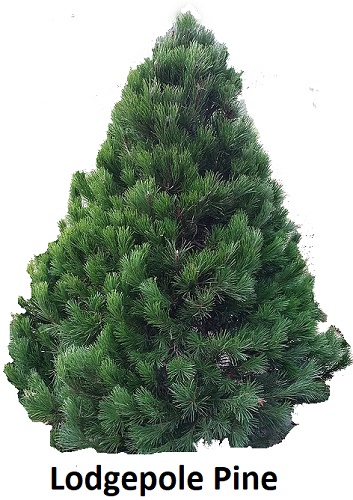 in the western in the western United States.
in the western in the western United States.
However, the Lodgepole
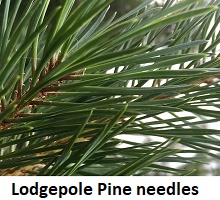 found greater popularity in the UK as a Christmas tree.
found greater popularity in the UK as a Christmas tree.
It was introduced to the UK in 1855 and growers like its resistance to pests and its ability to grow well on poor wet soils.
Mature trees grow to 30 metres.
Typically available from 4ft to 12ft - this a low needle drop tree.
It forms clean, gradually tapering shafts which were used by Native Americans to make their lodges, hence the name "lodgepole pine."
See the photo at right.
Scots Pine -

Sometimes called "Scotch Pine", this is one of the most common UK Christmas trees. The colour is a bright green.
It has stiff branches with stiff, dark green
needles one 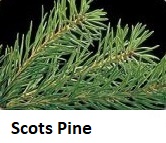 inch long; holds needles for four weeks; needles will stay on
even when dry. The tree has a naturally open appearance and more room for ornaments.
inch long; holds needles for four weeks; needles will stay on
even when dry. The tree has a naturally open appearance and more room for ornaments.
Scots Pines keeps aroma throughout the season. Fact: it was introduced into United States by European settlers.
One of the most common Christmas trees in the U.S., and still popular in Scotland, the Scots Pine has an excellent survival rate, is easy to replant, has great keeping qualities and will remain fresh throughout the holiday season. See photo at right.
White Pine -

The White Pine, sometimes called the Eastern White Pine, has soft, blue-green needles, 2 to 5 inches long in bundles of five; retains needles throughout the holiday season; very full appearance; little or no fragrance; less allergic reactions as compared to more fragrant trees. The largest pine in the U.S., the White Pine has soft, flexible needles and is bluish-green in colour.
Needles are 2 1/2 - 5 in. long. White Pine's have good needle retention, but have little aroma.
The slender branches will support fewer and smaller decorations as compared to Scots Pine.
They aren't recommended for heavy ornaments.
It's wood is used in cabinets, interior finish and carving.
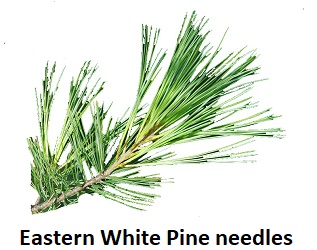
Native Americans used the inner bark as food and early colonists used the inner bark to make cough medicine.
Alternative Christmas trees
While the varieties below are rarely seen in the U.K. as cut trees for Christmas, they may be found at nurseries as potted trees, which makes them a good option for a small flat, a house plant or for planting in the garden after Christmas.

Cedars
Cedar trees are rarely used in the UK as a Christmas tree, but may be a good alternative in a year when supplies of other trees are tight.
Deodara Cedar
Cedars have short, bluish-green needles; branches become pendulous at the tips.
The tree is native to Himalayas.
Deodara wood in Asia was used to build temples. In ancient Egypt Dedodara wood was used to make coffins for mummies. Deodara Cedar More info
 Cypress
Cypress
Cypress, while grown in the UK and used in landscaping, are rarely used as Christmas trees.
But they have an advantage: if you are allergic to the sap of fir or pine trees, try a cypress; they're hypoallergenic!
Arizona Cypress -
Native southwestern cypress with soft- textured gray-green foliage.
Leland Cypress - 
Photo at right - foliage
is dark green to gray colour; has upright branches with a feathery
appearance; has a light scent; good for people with allergies to
other Christmas tree types.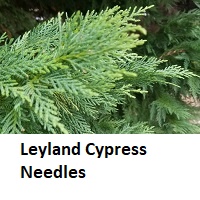 The Leyland Cypress is dark green - gray in colour and
has very little aroma. Because it is not in the Pine or Fir family,
it does not produce sap, so that those with an allergy to sap can
still enjoy a Leyland as their Christmas Tree.
The Leyland Cypress is dark green - gray in colour and
has very little aroma. Because it is not in the Pine or Fir family,
it does not produce sap, so that those with an allergy to sap can
still enjoy a Leyland as their Christmas Tree.
Potted Christmas trees
Norfolk Island Pine
A tree from the tropics, these make a great houseplant AND they look great decorated as a Christmas tree.
Gift ideas:
iRobot Roomba 960 Robot Vacuum Cleaner
or
Less expensive unbranded Robot Vacuum Cleaner with Mop, 4500Pa Ultra Strong Suction
or
Ninja Foodi MAX Dual Zone Air Fryer
Christmas tree accessories:
Christmas tree decorations
Tree Stand for Up To 8ft/2.5m Tall Cinco Advantage 8
1,000 LED Christmas-Tree Lights, 25 meters
Nearly Natural 3ft Norfolk Island Pine Artificial Tree
or a much less expensive
2 ft Norfolk Island pine
Tree Stand for Up To 8ft/2.5m Tall Cinco Advantage 8
Gift ideas:
iRobot Roomba 960 Robot Vacuum Cleaner
or
Less expensive unbranded Robot Vacuum Cleaner with Mop, 4500Pa Ultra Strong Suction
or
Ninja Foodi MAX Dual Zone Air Fryer
Christmas tree accessories:
Christmas tree decorations
Tree Stand for Up To 8ft/2.5m Tall Cinco Advantage 8
Star-Max F-H-S Start 1 Christmas Tree Stand for trees upto 2m
1,000 LED Christmas-Tree Lights, 25 meters
Christmas tree decorations
1,000 LED Christmas-Tree Lights, 25 meters
Find Other types of farms:
- Farmshops, farmers markets and roadside stands
- Pick Your Own Farms
- Christmas Tree Farms
- Local Honey Sources
- Local Meat, Milk and Eggs
- U.S. Road trips and camping

